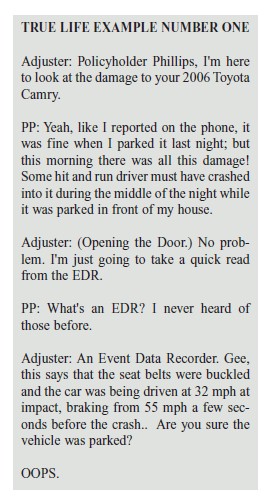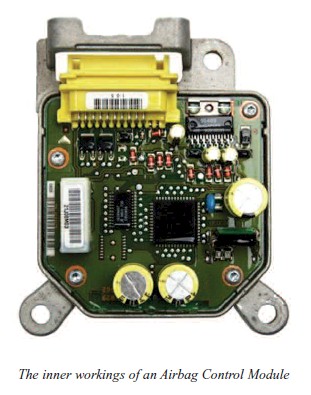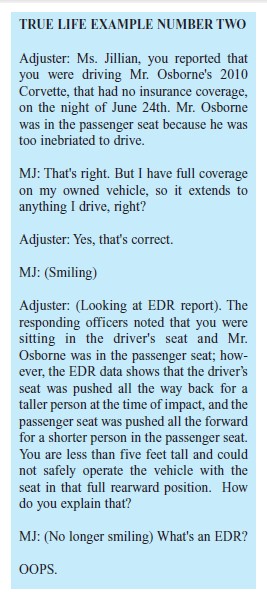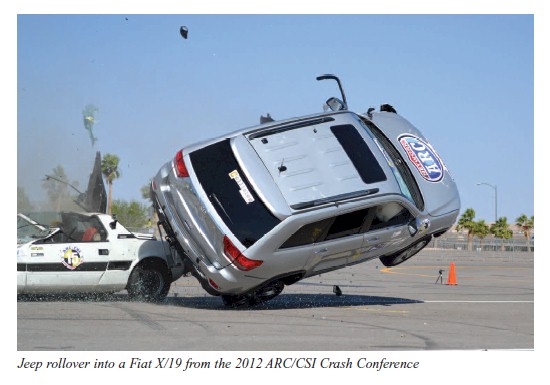Copyright held by The John Cooke Fraud Report. Reprint rights are granted with attribution to The John Cooke Fraud Report with a link to this website.
A NEW DIRECTION IN AUTO CLAIMS
By Lou Stanley
Fraud fighters are constantly looking for new approaches to old problems and old approaches to new problems. Within the realm of automobile claims, a sister industry has developed and implemented a tool that may have a huge impact on the future of insurance claims handling.

The Crash Data Retrieval (CDR Tool) is a combination of hardware and software that reads the crash data found in a vehicles’ Event Data Recorder (EDR). The EDR, a name coined by the National Highway Transportation Safety Administration (NHTSA), was developed to obtain the information needed to reduce deaths, injuries, and property damage due to vehicle crashes on the nation’s highways. EDRs give government researchers and investigators information with which they can assess motor vehicles crashes in real world events with real people. So even though it was developed for one purpose, it’s a valuable tool for another purpose. Claims investigations.
Think of an EDR as a vehicle’s “little black box”; one that is designed and programmed to record pure data — making EDRs a valuable objective tool in our arsenal. Sensors located throughout the vehicle feed information back to the ‘brains,’ or electronic control units (ECUs), contained within the vehicles Air Bag Control Module (ACM),which is typically found in a fairly well protected area, e.g. under the driver’s seat, the center console, or any other ‘safe’ and protected location.
 If a car hits a tree, the standard EDR data will reflect the exact speed of the car/tree impact, the acceleration or deceleration for a number of seconds before and just after impact, if the foot was on the brake or still on the gas, and many other items of fact. Imagine a very precise, multi-second, looping device that records and saves data at each and every triggering incident. It’s just that simple.
If a car hits a tree, the standard EDR data will reflect the exact speed of the car/tree impact, the acceleration or deceleration for a number of seconds before and just after impact, if the foot was on the brake or still on the gas, and many other items of fact. Imagine a very precise, multi-second, looping device that records and saves data at each and every triggering incident. It’s just that simple.
Using this real world data, government can develop more effective occupant protection and motor vehicle safety programs and manufacturers can collect information with which they can improve vehicle safety in a crash event, thereby enhancing safety in future generations of vehicles. Collected data can provide valuable information on the severity of the crash, operation of the air bag, and what deployment decision strategies were used during the event. EDRs are working for them just like they were intended to do.
What aspects of this event data is of value to insurers? Some of the collected data points include any change in forward crash speed, the maximum change in forward crash speed, the time from the beginning of the crash at which the maximum change in forward crash speed occurs, whether the gas pedal was pressed and whether the brake was applied, whether the driver’s seat belt was buckled before the crash, whether the air bag worked correctly, etc. Under specific conditions the EDR will also record the following information: sideways acceleration or force, forward or rearward acceleration or force, vertical acceleration or force, engine RPMs, whether the vehicle rolled over, steering wheel operation five seconds before the crash, and a host of other items you can check out in the tables near the end of this article.
Flash backward 45 years to the insurance world in the late sixties A Midwest insurer, at the top of its game, bought a Honeywell 58 computer — so technologically advanced that it allowed a machine to type policies with amazing speed, while, at the same time, generating billings to individual agents. Even more spectacular, in July 1969, a pilot named Michael Collins flew the Apollo 11 spacecraft to the moon — using some of that same astounding computer technology that so amazed those watching that Honeywell spit out policies. In the intervening 45 years, that initial technology has evolved to the point that every Apple iPhone carrying teenager has more computer power in his/her pocket than was used to make the 239,000-mile trip to the moon. Yes, really. Were we at the tip of the computer iceberg in 1969? Likewise, are we now at the tip of the EDR iceberg?
 There is nothing new about EDRs. The automobile manufacturing industry initially developed them because it needed not only to make a safer automobile, but to defend itself in cases of “he said/she said” litigation. The initial EDR technology accelerated into the public eye during the years of phantom acceleration claims against Toyota and has progressed since that time.
There is nothing new about EDRs. The automobile manufacturing industry initially developed them because it needed not only to make a safer automobile, but to defend itself in cases of “he said/she said” litigation. The initial EDR technology accelerated into the public eye during the years of phantom acceleration claims against Toyota and has progressed since that time.
Now, with the technology exactly as it is, an EDR readout will provide technical vehicle and occupant information for a short amount of time just priorautomobile, but to defend itself in cases of “he said/she said” litigation. The initial EDR technology accelerated into the public eye during the years of phantom acceleration claims against Toyota and has progressed since that time.
to an event, during an event, and for a brief period after an event. We are talking about seconds, not minutes, of data capture. It’s enough data for an insurance claims adjuster/fraud investigator to get a fairly good portrayal of what actually happened. Witnesses disagree because they must depend on perception and accurate recall to define an incident. But EDR technology is indisputable. Raw data is just that … raw data.
The EDR may record pre-crash vehicle dynamics and system status, driver inputs, restraint usage/deployment status, and postcrash data, such as activation of an automatic collision notification system. And while we instantly think of the airplane’s infamous black box as a comparison, there are major differences. The black box on a plane records everything about the flight for the entire duration. An EDR System, on the other hand, only records seconds of information. The airplane’s black box also records sound; the EDR unit does not. EDR readouts just give us technological details via numbers and measurements; none yet, at least as far as we know, include a voice clip, “Honey, slow down before you hit that …. SPLAT.”
 It is estimated that approximately 64% of vehicles had EDR capability during the year 2005. And each year, that percentage has increased. This data is there for the using. There are commercially available tools that read and report EDR data. What is involved in implementing it into the general claims adjusting system? At least three major insurers are currently running trials with EDR readers to ascertain the cost savings they could realize by learning to use this evolving tool. So far, the feedback has been promising, and the positive results are beginning to accumulate.
It is estimated that approximately 64% of vehicles had EDR capability during the year 2005. And each year, that percentage has increased. This data is there for the using. There are commercially available tools that read and report EDR data. What is involved in implementing it into the general claims adjusting system? At least three major insurers are currently running trials with EDR readers to ascertain the cost savings they could realize by learning to use this evolving tool. So far, the feedback has been promising, and the positive results are beginning to accumulate.
The considerations of a trial program include:
Standardization — While the majority of vehicles now on our highways have EDRs, there was never any absolute standardization between EDR reporting methods. EDR data is proprietary to each auto manufacturer. Ford has its version; Toyota has another version; and Honda, still another. What is different now? NHTSA has issued a regulation to standardize the data collected and recorded by an EDR. Beginning with the model year 2013, NHTSA defined the minimum data set (15 items) that must be collected if a manufacturer decides to voluntarily install an EDR in its vehicle lines, along with requirements for the range of accuracy of EDR data. Additionally, as of 2014, it is proposed that any new car sold in the United States must be equipped with an EDR. This also applies to foreign manufacturers; if you sell the vehicle in the united States, it’r got to have an onboard EDR. Period. Since the designs are proprietary, many manufacturers have significantly added to those minimum data points defined by NHTSA. Items of measurement are continually being added to the units, limited only by cost and imagination.
Cost of Equipment — If Gigantic Insurance Company (GIC) has 10 regional claims processing centers, the trial program shopping cart would look like this. Two regions (Atlanta serving the Eastern USA and Los Angeles serving the Western USA) would each own one top-of-the-line Premium EDR Tool (approximately $10,000 each). Satellite claims personnel; twenty four on each side of the country, forty eight in total would each get a basic EDR Tool, currently priced just under $3,000 each. (Both commercially available units can take the EDR data snapshots. Premium kits contain additional cables to take the EDR data snapshots from more seriously damaged vehicles.) EDR tool hardware is purchased one time with an annual software renewal required to keep up with manufacturer changes and data reporting abilities. Add in the cost of training and the cost to deliver that training to those so designated, and GIC is up and running for an amount that could conceivably be less than one serious fraudulent claim. After that, it’s all uphill.
Application — GIC’s 50 units would be in constant use. Capturing the data is not rocket science. The readout is, in effect, just one more witness statement, untarnished by memory ability, interpretation or any other human variable.

Recognition of Value — The old adage, “A picture is worth a thousand words” has lost much of its luster with the march of technology — at least a visual image. To be clear; in the case of EDR, there are no actual pictures. An EDR report is an objective printout of the crash data (or, consider, the lack of data if there was no measurable impact) and has withstood legal challenges because it rises above speculation. Courts can subpoena EDR data through court orders, and some States collect data under their existing State laws governing crash investigations. Some insurance policies may have contract terms related to data collection from EDRs. Nearly 100 court cases have used EDR data in the proceedings, showing a willingness to allow EDR data entered as evidence.
Right to Accessibility — Who owns the information collected by an EDR? Can the government, insurance investigators or police just waltz in and download the data? Ownership of the EDR and its data is a matter of state law, and such provisions vary considerably. NHTSA considers the owner of the vehicle to be the owner of the data collected from an EDR. The owner can give permission to download EDR data or courts can subpoena EDR data. Big city police agencies and Highway Patrol units that use the EDR tool collect data under their existing state laws governing crash investigations. For crash investigations conducted by NHTSA, the agency obtains permission from the vehicle owner before downloading the EDR data. Up-to-date policy language includes contract terms related to data collection from EDRs.

Once a year, late in the spring, the Las Vegas Speedway comes to life in a whole different way. An estimated 200 accident reconstruction specialists arrive to witness the latest antics (insanity being far too harsh of a word) of Rusty Haight, best described as the human crash dummy. Rusty, at last count, was within near striking distance (no pun intended) of hitting (again) the 1,000 crash mark. Those who know him well were said to be placing sideline wagers on what that 1,000th crash would look like.
During the course of staged crashes, the series of donated automobiles, trucks, and (this year) even a bus, have cameras installed on the inside — to allow a slow motion view of the body’s movement upon impact — and placed at strategic outside locations — to show, again in slow motion, the sometimes spectacular crumbling of the vehicles. Seeing is believing. A car traveling at 15 mph, straight into a concrete barrier, has near violent results for the properly belted driver. Any variation in vector can change the expected pattern of injury. Two cars, each traveling head-on at 15 mph, have combined velocity — and injuries increase accordingly.
During most staged crashes, Rusty wears a chest plate, which serves to spread the force exerted on his body from the seat belt. In the 15-mph crash, he left the plate behind — and while he suffered mightily, the pictures were all telling. In slow motion, two things were very evident. First, instead of the anticipated back/forth flexion extension, Rusty went up off of his seat and then rolled over the seat belt in a left torque. See the “Ask Doctor Bob” column in this issue for the expected biomechanical stressors vs. the actual biomechanical stressors. Even the old pros learned a thing or two; Rusty included.
EDRs trace their roots to the installation of air bags in vehicles. For air bags to operate properly in the event of a crash, automobile manufacturers developed control units to detect when a crash occurs and deploy the air bag if needed. Even the earliest EDR technology involved “thinking” units, albeit in a somewhat primeval form. (Input: big impact. Result: deploy airbags!). As the air bag control units became more sophisticated, automobile designers realized data collected from the control units could be used to further improve air bag design. To collect these data points, designers increased the functionally of the air bag control unit to permit storage of the data after a crash so it could be downloaded and analyzed later. They also learned to store events that were significant enough to register, but not significant enough to deploy the airbag.
Automatic collision notification (ACN) systems and EDRs are separate functions. ACN is a system that can automatically notify a third party (such as a 911 operator or a call center) when a car is involved in a collision. Some cars and light trucks have ACN devices, such as GM’s On- Star™ system. Some of these systems use data from the EDR to determine crash severity, thereby helping to ensure an appropriate level of medical response. Technology allows the ambulance to be summoned even if the driver is upside down in a ditch and unconscious.
NEW EMERGING APPLICATIONS
While EDR reports have been widely used by law enforcement and the accident reconstruction communities, there is currently a push to involve EDR reporting in the used car and fleet management industries to help improve the transparency of the vehicle being offered for sale and close the gap in vehicle history reporting. A typical scenario would be to get the EDR data from a vehicle being brought in for a trade-in or lease return to get a true representation of the vehicles condition. An EDR report may help analyze the vehicle safety systems along with verification that there are no unreported stored events that may degrade the vehicles safety systems or the vehicle itself. Again, while the system was initially developed for one purpose, could not the same technology become an integral aspect of new policy underwriting?
ADDITIONAL INFORMATION
Many States are considering legislation to regulate EDR disclosure, data ownership, and other privacy concerns. Some States have already passed such laws. State Attorney-General’s offices can provide information on any State regulations affecting EDRs.
Those interested in additional information and research about EDRs can examine the NHTSA EDR web site at: http://www-nrd.nhtsa.dot.gov/edr-site/index.html
PREDICTION TIME
What does the future hold for EDR technology? The majority of vehicles on the roads — and thus the majority of vehicles involved in claims — are equipped with the units. Objective information is at our fingertips, some with the potential to replace conflicting witness statements, assist in lengthy court battles, determine true liability, and take the guess work out of many accident scenarios. Major carriers have already gone to computer aided adjusting (while still retaining the human element); it may be just a matter of time before EDRs become routine underwriting and claims tools.
EDR tool hardware is purchased one time with an annual software renewal required to keep up with manufacturer changes and data reporting abilities. It took more than 40 years to get from Honeywells to I-phones. It’s going to be far less time to get from the claims world of today to the the claims world of ten years from now.

————————
Our thanks to the Crash Data Group for their assistance in gathering the material to write this article and for supplying the photographs and information charts provided. For more information, see their web site at http://www.cdr-system.com/ or call 800- 280-7940. Lou Stanley is a retired computer analytics engineer. A prolific writer, “Through the Eyes of a Criminal” was his first novel. He currently works part time as an independent security consultant and is the Emerging Technology writer for The John Cooke Fraud Report.


